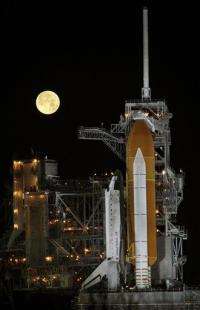A full moon begins to set as the space shuttle Discovery sits on Kennedy Space Center's Launch Pad 39-A before sunrise Wednesday morning March 11, 2009 in Cape Canaveral, Fla. Discovery and her crew of seven astronauts is making final preparations for this evening's planned liftoff on a 14-day mission to the international space station. (AP Photo/Chris O'Meara)
(AP) -- NASA fueled space shuttle Discovery for a night flight to the international space station Wednesday, following a month's delay to make sure the ship's valves are just right.
Forecasters expected ideal weather and a rising full moon for the 9:20 p.m. launch.
At midday, the launch team began filling Discovery's giant tank with more than 500,000 gallons of fuel and the seven astronauts assigned to the flight underwent final medical checks.
Discovery is a month late in its mission to deliver a final set of solar wings to the space station. Liftoff originally was targeted for mid-February, but concern about the shuttle's hydrogen gas valves resulted in four delays.
Shuttle managers said they're convinced after extensive testing that the three valves aboard Discovery are safe and won't break like one did during the last shuttle launch in November. The valves are part of the main propulsion system.
The cargo on Discovery includes 31,000 pounds of framework that holds two folded-up solar wings and a radiator. The space station already has six electricity-producing wings; the two going up will be the last ones and elevate the orbiting outpost to full power.
Even though they're the last to fly, these solar wings are the oldest. They were used for testing and have been at Kennedy Space Center since 2002. As a result, engineers consider them "an old friend," said payload manager Robert Ashley.
"We're excited about the impending launch, but at the same time there will be a little sadness as this will mark the end of an era for the space station program," Ashley said.
This $300 million segment, in fact, is the last major American-made piece of the space station to be launched.
Once the astronauts install the framework and the 115-foot-long wings are unfurled, the space station will be more than 80 percent complete. Construction is scheduled to wrap up next year, coinciding with the retirement of NASA's space shuttles. A new rocketship is in the works, though, to ferry astronauts to the space station and eventually fly crews to the moon.
Two one-time schoolteachers are on Discovery's crew and will take part in the mission's four spacewalks. Joseph Acaba and Richard Arnold II were chosen as educator astronauts in 2004, following in the footsteps of Barbara Morgan, who rocketed into orbit in 2007. Morgan was the backup for Christa McAuliffe, who died aboard Challenger in 1986.
A Japanese astronaut, Koichi Wakata, also is going up on Discovery. He will become the first person from his country to live on the international space station, an achievement that has drawn more than 200 Japanese to NASA's launching site.
---
On the Net:
NASA: http://spaceflight.nasa.gov
©2009 The Associated Press. All rights reserved. This material may not be published, broadcast, rewritten or redistributed.






















